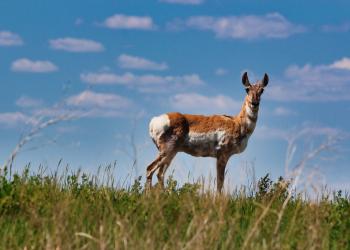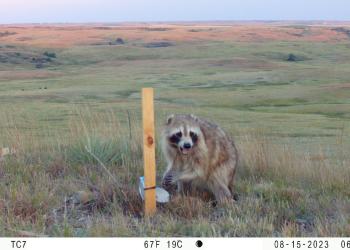Animals and Plants
Each of the National Grasslands within the Dakota Prairie Grasslands has its unique, distinguishing flavor. The tallgrass prairie on the Sheyenne National Grassland significantly contrasts the stark badlands found in the Little Missouri National Grassland or the rolling hills, river breaks, and mixed grass prairie of the Grand River and Cedar River National Grasslands. The amazing scenery is filled with various floras and faunas that inspires wonder and awe of the natural world. We invite you to explore these treasured grasslands and enjoy the many opportunities. Before you visit, download the Plant and Wildlife Checklist and to keep track of the flora and fauna you may spot.
Animals

The fauna of the Dakota Prairie Grasslands features a diverse ecosystem, that supports a rich variety of mammals, birds, reptiles, insects, and so much more.
Plants

The flora of the Dakota Prairie Grasslands features a diverse ecosystem, which is dominated by native grasses and forbs. Certain areas have woody plants, including trees and shrubs.
Birding in the Grasslands

The Dakota Prairie Grasslands is home to a diverse and fascinating array of birdlife. Some species are perpetual residents, while others are migratory, making the region a crucial breeding and stopover area. Explore the birding opportunities across the four Ranger Districts on the Birding in the Grasslands page.
Grouse Gatherings in the Grasslands

The Dakota Prairie Grasslands wildlife biologists monitor three species of prairie grouse, including sharp-tailed grouse, greater sage-grouse, and greater prairie chickens at dancing grounds across the grasslands each spring.
The Grouse in the Grasslands page that offers a photo gallery, plus an article highlighting the sharp-tailed grouse.
Animal Studies and Surveys in the Grasslands

The Forest Service conducts various animal studies and surveys in the Dakota Prairie Grasslands to understand population dynamics, habitat requirements, and the impact of management practices on wildlife. Learn more about the fascinating work they do and some of the interesting characters they see.
Published Resources in the Grasslands
PLANTS OF THE GRAND RIVER & CEDAR RIVER NATIONAL GRASSLANDS

by Kurt Hanson
The Cedar River and Grand River National Grasslands contain a variety of habitats. The mixed-grass prairie, cottonwood riparian, and woody draws characteristic of the Northern Great Plains are all here, as are sandstone ridges, sand dunes, and badlands. This diversity creates a welcoming site for plant enthusiasts.
Plants of the Sheyenne National Grassland

The Sheyenne National Grassland is located in southeastern North Dakota, comprising 70,200 acres of public land. It is characterized by sandy soils, originally deposited as the delta of an ancient river as it emptied into glacial Lake Agassiz. Since that time, wind and rain have shaped the topography into a unique landscape ranging from flat deltaic plains to choppy sand dunes. It is the only National Grassland in the tallgrass prairie region of the United States.
Nearly 800 plant species may be found on the Grassland; however, only 88 have been highlighted in this booklet.
Photographs were provided by Stacy Swenson, Bernadette Braun, Keith Frankki, Lauren Dennhardt, Cory Enger, Katy Chaka and Peter Dziuk of Minnesota Wildflowers, Bernd Haynold, and Meghan Dinkins.
The production of this brochure was made possible through a cooperative agreement with Val-ley City State University.
Birds on the Sheyenne National Grassland

BIRD STATUS AND DISTRIBUTION ON THE SHEYENNE NATIONAL GRASSLAND: 2010
By Dan Svingen and Ron Martin
Birds on the Cedar River & Grand River National Grasslands

BIRD STATUS AND DISTRIBUTION ON THE CEDAR RIVER & GRAND RIVER NATIONAL GRASSLANDS: 2011
By Dan Svingen, David Griffiths, and Carolyn Griffiths



